1970 Atlantic hurricane season
The 1970 Atlantic hurricane season was the first season of the most recent low-activity era (“cold phase”) of tropical cyclone formation in the Atlantic. It was also the first year in which reconnaissance aircraft flew into all four quadrants of a tropical cyclone.[1] The season officially began on June 1 and lasted until November 30. These dates conventionally delimit the period of each year when most tropical cyclones form in the Atlantic basin. The season was fairly average, with 10 total storms forming, of which five were hurricanes. Two of those five became major hurricanes, which are Category 3 or higher on the Saffir–Simpson scale. The first system, Hurricane Alma, developed on May 17. The storm killed eight people, seven from flooding in Cuba and one from a lightning strike in Florida. In July, Tropical Storm Becky brought minor flooding to Florida and other parts of the Southern United States, leaving one death and about $500,000 (1970 USD) in damage.
| 1970 Atlantic hurricane season | |
|---|---|
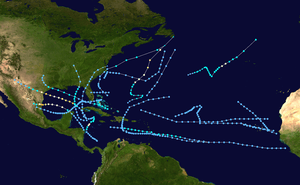 Season summary map | |
| Seasonal boundaries | |
| First system formed | May 17, 1970 |
| Last system dissipated | October 28, 1970 |
| Strongest storm | |
| Name | Celia |
| • Maximum winds | 125 mph (205 km/h) (1-minute sustained) |
| • Lowest pressure | 945 mbar (hPa; 27.91 inHg) |
| Seasonal statistics | |
| Total depressions | 19 |
| Total storms | 10 |
| Hurricanes | 5 |
| Major hurricanes (Cat. 3+) | 2 |
| Total fatalities | 111 total |
| Total damage | $1.03 billion (1970 USD) |
| Related articles | |
The most significant storm of the season was Hurricane Celia, a Category 3 hurricane that slammed South Texas in early August. Celia resulted in about $930 million in damage and was the costliest hurricane in Texas until Alicia in 1983. There were 28 fatalities, with four in Cuba, eight in Florida, and sixteen in Texas. Later that month, Tropical Storm Dorothy caused severe flooding in Martinique, which left up to 51 deaths and $34 million in damage. One death occurred in Mexico as a result of Hurricane Ella after a house collapsed. In October, Tropical Depression Fifteen brought a devastating flood to Puerto Rico. At least 22 fatalities and $65.5 million in damage occurred. Collectively, the storms of this season left at least $1.03 billion in damage and 115 deaths.
Season summary


The Atlantic hurricane season officially began on June 1,[2] though activity began slightly earlier with Hurricane Alma forming on May 17.[3] Although 23 tropical depressions developed, only ten of them reached tropical storm intensity;[3] this was comparable to the 1950–2000 average of 9.6 named storms per season.[4] Five of these reached hurricane status,[3] slightly under the 1950–2000 average of 5.9.[4] Furthermore, two storms reached major hurricane status,[3] near the average 1950–2000 average of 2.3.[4] Collectively, the cyclones of this season caused at least 115 deaths and over $1.03 billion in damage.[5] The Atlantic hurricane season officially ended on November 30,[2] though the final tropical cyclone became extratropical on October 28.[3]
Tropical cyclogenesis began in May, with Alma developing on May 17. No tropical cyclone activity occurred in June. Three systems originated in July, including Tropical Storm Becky and the depression that would eventually intensify into Hurricane Celia, as well as another tropical depression that remained below tropical storm intensity. Celia became the most intense tropical cyclone of the season on August 3, peaking as a Category 3 hurricane on the Saffir–Simpson scale with maximum sustained winds of 125 mph (205 km/h) and a minimum barometric pressure of 945 mbar (27.91 inHg).[3] In August, four tropical systems developed, including an unnamed tropical storm, Dorothy, and three other tropical depressions. September eight featured tropical depressions, though only three became named storms – Ella, Felice, and Greta.[6] October featured two unnamed hurricanes, the second of which became an extratropical cyclone on October 28, ending the season's activity.[3]
The season's activity was reflected with an accumulated cyclone energy (ACE) rating of 40.[7] ACE is, broadly speaking, a measure of the power of the hurricane multiplied by the length of time it existed, so storms that last a long time, as well as particularly strong hurricanes, have high ACEs. It is only calculated for full advisories on tropical systems at or exceeding 39 mph (63 km/h), which is tropical storm strength.[8]
Systems
Hurricane Alma
| Category 1 hurricane (SSHWS) | |
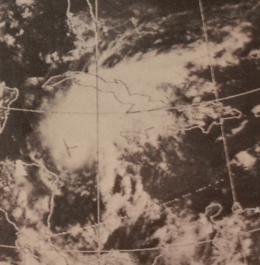 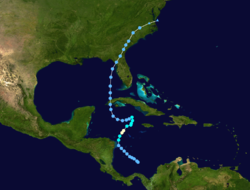 | |
| Duration | May 17 – May 26 |
|---|---|
| Peak intensity | 80 mph (130 km/h) (1-min) 993 mbar (hPa) |
An area of disturbed weather persisted over the southwestern Caribbean in the middle of May. It gradually organized,[1] and a tropical depression formed on May 17.[3] In response to low wind shear and warm sea surface temperatures,[1] the depression rapidly strengthened to a tropical storm early on May 20 and to a hurricane that night. However, increasing upper-level wind shear caused Alma to deteriorate back into a tropical depression tropical depression on May 22.[1][3] The depression continued its general northward movement, with a brief jog to the west, and struck Cuba on May 24 with maximum winds of 30 mph (48 km/h).[3] As Alma crossed the eastern Gulf of Mexico, it retained a well-defined circulation with an eye feature evident on weather radar, but the persistent shear limited the system's intensity.[1] Tropical Depression Alma made landfall near Cedar Key, Florida, on May 25 and became extratropical two days later over North Carolina.[3]
Although Alma passed just offshore, impact in Central America, if any, is unknown.[1] In the Cayman Islands, winds of 65 mph (105 km/h) were reported.[9] Impact was most severe in Cuba, where flash flooding caused seven fatalities,[1][10] destroyed several homes, forced the evacuation of 3,000 people in Oriente Province, and forced 16 sugar mills to suspend operations.[10] The storm brought light rainfall to Florida, though precipitation peaked at 6.66 in (169 mm) near Miami.[11] Thunderstorms caused one death in Miami and damaged some buildings in Fort Myers.[12][13] In other states, impact came mostly in the form of rain, though a tornado near Columbia, South Carolina, unroofed one building.[14]
Tropical Storm Becky
| Tropical storm (SSHWS) | |
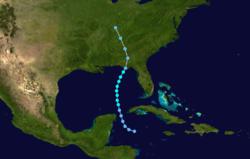 | |
| Duration | July 19 – July 23 |
|---|---|
| Peak intensity | 65 mph (100 km/h) (1-min) 1003 mbar (hPa) |
A large disturbance began to detach from the Intertropical Convergence Zone near Panama on July 16.[1] By July 19, the disturbance developed into a tropical depression. After tracking through the Yucatán Channel, the depression became Tropical Storm Becky on July 20. Becky tracked northward to north-northeastward across the Gulf of Mexico and eventually strengthened to reach peak winds of 65 mph (100 km/h) late on July 20.[3] Thereafter, upper level winds began weakening the storm.[1] By July 22, Becky made landfall near Port St. Joe, Florida, as a tropical depression. The storm weakened further over land, eventually dissipating over western Kentucky on the July 23.[3]
Throughout Florida, Becky produced mostly light rainfall and gale-force winds. However, in Tallahassee, the storm dropped more than 8 in (200 mm) of rain, which caused flooding in and around the city.[1] According to the Red Cross, 104 families in the Tallahassee region suffered flood-related losses. Additionally, two injuries were reported.[15] Some houses near Tallahassee were flooded with 4 ft (1.2 m) of water, resulting in the evacuation of 15 households by rowboat. More than 100 cars in the area were also submerged.[16] In nearby Wakulla County, knee-deep waters were reported at the county courthouse in Crawfordville.[15] A tornado spawned near Panacea, destroyed a house and damaged two others. Light to moderate rain fell in neighboring states, and a tornado in Georgia caused one fatality and destroyed two homes.[1]
Hurricane Celia
| Category 3 hurricane (SSHWS) | |
 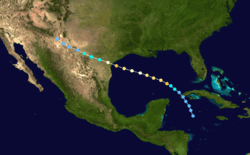 | |
| Duration | July 31 – August 5 |
|---|---|
| Peak intensity | 125 mph (205 km/h) (1-min) 945 mbar (hPa) |
A tropical wave emerged into the Atlantic Ocean from the west coast of Africa on July 23. It moved rapidly westward and reached the western Caribbean Sea by July 30.[1] On the following day, the system developed into a tropical depression near Grand Cayman. The depression tracked north-northwestward without significantly strengthening and struck crossed western Cuba on August 1. The depression entered the Gulf of Mexico and was upgraded to Tropical Storm Celia later on August 1.[3] Due to warm sea surface temperatures,[1] Celia rapidly intensified into a Category 3 hurricane on August 1. Early on August 2, Celia began to weaken and fell to Category 2 intensity. The storm weakened further to a Category 1 hurricane on August 3. However, while approaching the Texas coastline later that day, Celia began to rapidly intensify again. At 1800 UTC on August 3, Celia peaked with sustained winds of 125 mph (205 km/h) and a minimum pressure of 945 mbar (27.91 inHg). Late on August 3, Celia made landfall near Corpus Christi, Texas. Celia weakened while moving further inland and dissipated over New Mexico on August 6.[3]
In Cuba, heavy rains on the island caused severe flooding, leading to five fatalities.[1] Storm surge and swells lashed the west coast of Florida, especially the Panhandle. Several life guard rescues occurred, while eight people drowned.[17] In Louisiana, abnormally tides caused minor coastal flooding.[18] The strongest sustained wind speeds in Texas were around 120–130 mph (190–210 km/h), while winds gusts were estimated to have reached as high as 180 mph (290 km/h) in Nueces County.[17] Much of the damage was caused by a series of microbursts and downbursts, most of which occurred in a 15-minute span.[19] Severe damage was reported in Nueces County, with 85% of Celia's total property losses caused in Corpus Christi alone. Approximately 90% of downtown buildings were damaged or destroyed, while about one-third of homes in the city suffered severe impact or were demolished.[17] Throughout the state, 8,950 homes were destroyed and about 55,650 others were damaged. About 252 small businesses, 331 boats, and 310 farm buildings were either damaged or destroyed.[20] In Texas, Celia caused 15 deaths and $930 million in damage.[21]
Tropical Storm Eight
| Tropical storm (SSHWS) | |
 | |
| Duration | August 7 – August 18 |
|---|---|
| Peak intensity | 70 mph (110 km/h) (1-min) 992 mbar (hPa) |
A tropical depression developed about 95 mi (155 km) east-northeast of the Abaco Islands in the Bahamas at 12:00 UTC on August 15. Initially, the depression moved west-northwestward before turning northward early the following day. Around 06:00 UTC on August 16, the system made landfall near Beaufort, North Carolina, with winds of 35 mph (55 km/h). After re-emerging into the Atlantic early on August 18, the depression moved northeastward and intensified into a tropical storm.[3] The ship Hotel observed sustained winds of 65 mph (100 km/h) around that time.[1] At 18:00 UTC, the storm peaked with winds of 70 mph (110 km/h) and a minimum pressure of 992 mbar (29.29 inHg). Shortly thereafter, the cyclone became extratropical about 180 mi (290 km) east of Sable Island.[3]
Along the coast of North Carolina, higher than normal tides capsized about 20 boats, including a 68 ft (21 m) yacht.[17] At Salvo, where the tide may have reached 4 ft (1.2 m) above normal, boardwalks and camping equipment were damaged at the campgrounds. Heavy squalls produced winds as strong as 75 mph (120 km/h) in Atlantic Beach.[22] Minor wind damage was reported in Atlantic Beach and Morehead City, primarily limited to some trees, power lines, roof shingles, television antennas, and signs.[22][23] From North Carolina to Maryland, lifeguards made dozens of rescues.[24] Four drowning deaths occurred, with two in North Carolina and two in Virginia.[23][24][25]
Tropical Storm Dorothy
| Tropical storm (SSHWS) | |
.jpg)  | |
| Duration | August 17 – August 23 |
|---|---|
| Peak intensity | 70 mph (110 km/h) (1-min) 996 mbar (hPa) |
A tropical wave moved off the western coast of Africa on August 13. Moving westward,[26] a tropical disturbance spawned by the wave led to the formation of a tropical depression beginning 500 mi (800 km) east of the Lesser Antilles on August 17. As it moved west-northwestward, it slowly intensified, and was upgraded to Tropical Storm Dorothy on August 19. By the following day, Dorothy attained its peak intensity with maximum sustained winds of 70 mph (110 km/h). Around that time, Dorothy crossed the island of Martinique. After passing through the Lesser Antilles, Dorothy moved under an upper-level cold-core trough, which caused the storm to weaken. On August 23, Dorothy dissipated south of the Tiburon Peninsula of Haiti.[27]
Throughout the Lesser Antilles, Dorothy produced high winds and heavy rainfall. On Martinique, large amounts of precipitation resulted in flooding and mudslides, which in turn, caused bridge collapses and damage to homes.[28] In addition, strong tropical storm force winds were also reported on the island. The storm destroyed 186 homes and left 700 people homeless.[29] Banana, sugar cane, and other crops sustained heavy losses. Flooding rains also overspread Dominica and Guadeloupe, but with less severe effects.[28][30] While the exact death toll of Dorothy is unknown, some sources claim that as many as 51 fatalities occurred.[27] Storm damage amounted to $34 million.[28]
Hurricane Ella
| Category 3 hurricane (SSHWS) | |
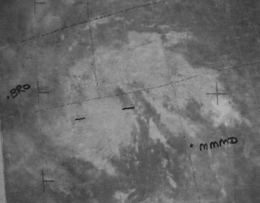 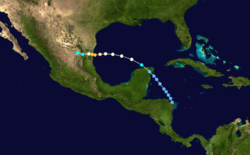 | |
| Duration | September 8 – September 13 |
|---|---|
| Peak intensity | 125 mph (205 km/h) (1-min) 967 mbar (hPa) |
A well-defined trough spawned a tropical depression near Cabo Gracias a Dios, Honduras, on September 8.[1][3] The depression moved northwestward without intensifying before striking Tulum, Quintana Roo, on September 10. Hours later, the system emerged into the Gulf of Mexico and soon strengthened into Tropical Storm Ella.[3] A ridge to the north caused it to curve in a general westward direction.[1] Just six hours after becoming a tropical storm, Ella intensified into a hurricane early on September 11. While approaching the Gulf Coast of Mexico, the cyclone deepened significantly, peaking as a Category 3 hurricane on September 12 with winds of 125 mph (205 km/h) and a minimum pressure of 967 mbar (28.56 inHg). Shortly thereafter, Ella made landfall near La Pesca, Tamaulipas, at the same intensity. The hurricane rapidly weakened inland, falling to tropical storm intensity on September 13 and dissipating several hours later.[3]
In the Yucatán Peninsula, wind gusts of 55 mph (90 km/h) were observed.[31] Ella brought heavy rainfall to portions of northeastern Mexico.[32] Several homes were destroyed and villages along the San Marcos River were inundated by water.[33] One girl died after her house collapsed. Flooding and continuous precipitation prevented the transportation of relief items, including food and medicine, by helicopters.[34] In Texas, tides peaked at 7 ft (2.1 m) above normal, but no coastal flooding damage was reported.[35]
Tropical Storm Felice
| Tropical storm (SSHWS) | |
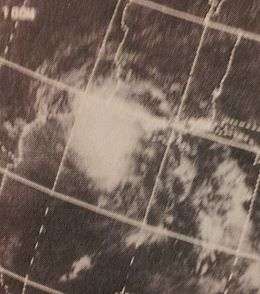  | |
| Duration | September 12 – September 17 |
|---|---|
| Peak intensity | 70 mph (110 km/h) (1-min) 997 mbar (hPa) |
On September 12, a tropical depression developed from an upper-level trough just south of Abaco Islands.[1] Without significant intensification, the system crossed the Florida Keys and entered the Gulf of Mexico.[3] Felice remained a disorganized storm for its entire duration, plagued by dry air, a lack of deep thunderstorm activity, and an ill-defined center of circulation.[1] However, early on September 16, the cyclone peaked with maximum sustained winds of 70 mph (110 km/h) and a minimum barometric pressure of 997 mbar (29.44 inHg). Felice tracked northwestward and brushed southern Louisiana on September 15, before making landfall near Galveston, Texas, later that day. Once ashore, Felice quickly deteriorated as it recurved into the central United States, dissipating on September 17.[3] While over southeastern Oklahoma, however, its remnants still closely resembled a formidable tropical cyclone.[36]
In advance of the cyclone, officials advised residents in vulnerable communities to evacuate their homes,[37] and temporary storm shelters were established.[38] However, the effects from Felice were generally light. Beneficial rains fell over parts of southern Florida,[39] while sections of coastal Louisiana experienced minimal gale-force winds and above-normal tides.[40] In Texas, winds gusting to 55 mph (89 km/h) at Galveston—and estimated near 70 mph (110 km/h) elsewhere—caused scattered power outages and minor tree damage,[41] while heavy rainfall totaling over 6 in (150 mm) triggered some street flooding.[11][41] Felice delayed the local rice harvest and ruined some hay that had been cut before the storm.[41] Significant precipitation and gusty winds accompanied the system into northern Texas and Oklahoma.[36]
Tropical Depression Fifteen
| Tropical depression (SSHWS) | |
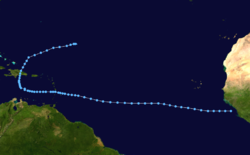 | |
| Duration | September 23 – October 11 |
|---|---|
| Peak intensity | 35 mph (55 km/h) (1-min) 1000 mbar (hPa) |
A long-lived depression formed on September 24 just off the west coast of Africa, and for several days maintained a general westward track. It passed through the Lesser Antilles on October 1, and later stalled in the eastern Caribbean Sea. On October 8, the depression crossed the eastern portion of the Dominican Republic, and subsequently accelerated to the northeast. It dissipated as a tropical cyclone on October 12, although its remnants persisted for another week before dissipating in the westerlies near the Azores.[3][6]
The depression produced heavy rainfall in the Lesser Antilles, reaching 12 in (300 mm) on Barbados;[42] it left three deaths and moderate damage on the island.[43] Another death was reported in the United States Virgin Islands. Torrential rainfall in Puerto Rico inflicted heavy damage, with precipitation peaking at 41.68 in (1,059 mm) in Jayuya,[11] of which 17 in (430 mm) fell in a 24‑hour period, far exceeding the peak rainfall amounts during the 1928 and 1899 hurricanes.[6] Most of the damage was inflicted to sugar cane and coffee crops.[44] Additionally, at least 600 houses were destroyed and another 1,000 sustained damage,[45] while about 10,000 people were left homeless.[44] The storm affected at least 40 state roads,[46] including 15 blocked by landslides, and 11 bridges destroyed.[47] Overall, damage in Puerto Rico totaled $65 million. At least 18 people were killed on the island,[6] and the system was considered one of the worst disasters in Puerto Rican history.[47]
Tropical Storm Greta
| Tropical storm (SSHWS) | |
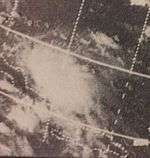  | |
| Duration | September 26 – October 5 |
|---|---|
| Peak intensity | 50 mph (85 km/h) (1-min) 1004 mbar (hPa) |
A tropical wave exited western Africa and emerged into the Atlantic Ocean on September 15. It moved slowly westward until September 22, when a high-pressure area caused it to accelerate west-northwestward towards the Leeward Islands.[26] By the next day, the wave interacted with a cold-core low, producing an area of convection. As the system moved over warmer waters, a surface low formed on September 26.[48] As a result of gale-force winds being observed, the system was then designated as Tropical Storm Greta. However, the storm did not strengthen, despite favorable conditions, and as a result, it was described by the National Hurricane Center (NHC) as a "bomb that did not explode".[1][49]
While approaching the Florida Keys, Greta abruptly weakened to a tropical depression, coinciding with deterioration of the cloud pattern. In addition, Hurricane Hunters reported rising pressures and lower winds. On the evening of September 27, Greta made landfall in Key West, Florida, with sustained winds of 26 mph (42 km/h).[49] Once in the Gulf of Mexico, Greta did not re-intensify, though it retained a closed circulation while moving around a high-pressure area. It moved across the northern Yucatán Peninsula, though it quickly re-emerged into the Gulf of Mexico. Eventually, Greta made landfall near Tampico, Mexico, on October 5, and dissipated shortly thereafter.[1] Due to the weak nature of the storm, minimal impact was reported. In Florida, tides were generally minor, and were no more than 3 and 4 feet (0.91 and 1.22 m) above normal, as reported in the Florida Keys.[50] Rainfall was mostly light, though 8.94 in (227 mm) of precipitation was observed in Fort Pierce.[48]
Hurricane Eighteen
| Category 2 hurricane (SSHWS) | |
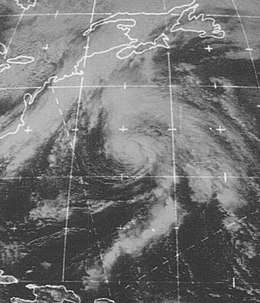 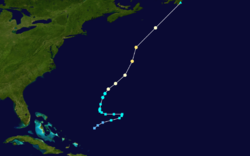 | |
| Duration | October 12 – October 17 |
|---|---|
| Peak intensity | 105 mph (165 km/h) (1-min) 974 mbar (hPa) |
On October 12, a subtropical depression developed while located northeast of the Bahamas. It steadily intensified and became a subtropical storm by the following day. After tracking east-northeastward, the storm made a sharp westward turned, followed by a curve to the north-northeast. After fully acquiring tropical characteristics, the subtropical storm transitioned into a tropical cyclone early on October 16. Twelve hours later, the storm strengthened into a hurricane,[3] shortly before passing near Bermuda.[51] It continued to intensify and briefly became a Category 2 hurricane on October 17. The hurricane then accelerated rapidly northeastward,[3] and made landfall on the Avalon Peninsula of Newfoundland as a Category 1 hurricane. Shortly thereafter, the hurricane transitioned into an extratropical cyclone on October 17.[3][52]
The hurricane produced high winds on Bermuda, canceling classes, interrupting transportation, and closing businesses, though damage was minimal.[53] In addition, light rain fell on the island.[11] Throughout Newfoundland, hurricane-force winds caused damage to structures, mostly in the form of broken windows. Rough seas along the Atlantic coast of the island damaged fishing dories and a fishing ramp. Heavy rainfall was also reported in some areas of the region, reaching nearly 5 in (130 mm) in Quebec. Damage on the Burin Peninsula was in the thousands of Canadian dollars, although the specific figure is unknown. On the French territory of Saint Pierre and Miquelon, several buildings lost their roof due to high winds.[52]
Hurricane Nineteen
| Category 1 hurricane (SSHWS) | |
  | |
| Duration | October 20 – October 28 |
|---|---|
| Peak intensity | 75 mph (120 km/h) (1-min) 988 mbar (hPa) |
A subtropical depression developed about 970 mi (1,560 km) east-northeast of Bermuda at 12:00 UTC on October 20. After intensifying into a subtropical storm early the following day, further strengthening was slow. Initially, the system northeastward, but curved southeastward on October 24. During that time, it began acquiring characteristics of a tropical cyclone, transitioning into a tropical storm at 12:00 UTC. The storm resumed its northeastward motion and continued to intensify. Early on October 27, the storm strengthened into a hurricane.[3] based on a report of winds of 75 mph (120 km/h) from the Pretoria several hours later. At the time of hurricane intensity, it is likely that the hurricane-force wind field was only 6 mi (9.7 km) in radius and its tropical storm force wind field was only 69 mi (111 km) in diameter.[1] By 12:00 UTC on October 27, the cyclone weakened to a tropical storm and began accelerating. About 24 hours later, the system transitioned into an extratropical cyclone while situated approximately 500 mi (800 km) north-northeast of Graciosa in the Azores.[3]
Other systems
In addition to the ten named storms of 1970 and the notable Tropical Depression Fifteen, there were several minor systems that were also classified as depressions by the NHC. A tropical depression developed offshore of North Carolina on July 27. Initially, the depression tracked toward the Outer Banks, but veered east-southeastward and avoided landfall. While nearing Bermuda on July 30, the depression slowly curved north-northeastward. By late on August 1, the depression dissipated while located east of Cape Race, Newfoundland. Tropical Depression Five developed on August 2 in the vicinity of Cape Verde. It moved west-northwestward across the eastern-North Atlantic Ocean and eventually curved nearly due eastward. The depression dissipated about halfway between Puerto Rico and the west coast of Africa on August 6. While Tropical Depression Nine was dissipating in the open Atlantic on August 5, Tropical Depression Ten developed near the Bahamas. By the following day, the depression made landfall near Palm Bay, Florida, and dissipated early on August 7.[3]
On August 7, Tropical Storm Seven developed over the eastern Atlantic. It moved westward toward the Lesser Antilles, before dissipating northeast of the islands on August 12. The next depression originated about halfway between the Lesser Antilles and Cape Verde on September 3. The system moved west-southwestward for much of its duration and dissipated by September 9. Another tropical depression began just offshore Dakar, Senegal, on September 5. It crossed through Cape Verde before dissipating on September 7. Later that month, the next system formed just east of Cape Verde on September 22. The depression dissipated on September 25, after moving northwestward across the far eastern Atlantic. On September 29, a system developed about 400 mi (640 km) southeast of Bermuda. The depression moved rapidly north-northeastward and dissipated about 280 mi (450 km) south of Cape Race, Newfoundland, on October 1.[6]
Storm names
The following names were used for named storms (tropical storms and hurricanes) that formed in the North Atlantic in 1970.[2] A storm was named Felice for the first time in 1970. Names that were not assigned are marked in gray. The name Celia was later retired and replaced by Carmen in the 1974 Atlantic hurricane season.[54]
|
|
Season effects
This is a table of the storms in 1970 and their landfall(s), if any. Deaths in parentheses are additional and indirect (an example of an indirect death would be a traffic accident), but are still storm-related. Damage and deaths include totals while the storm was extratropical or a wave or low.
| Name | Dates active | Peak classification | Sustained wind speeds |
Pressure | Areas affected | Damage (USD) |
Deaths | Refs |
|---|---|---|---|---|---|---|---|---|
| Alma | May 17 – 26 | Category 1 hurricane | 80 mph (130 km/h) | 993 hPa (29.32 inHg) | Cayman Islands, Jamaica, Cuba, Southeastern United States | Minor | 8 | [10][55] |
| Becky | July 19 – 23 | Tropical storm | 65 mph (100 km/h) | 1003 hPa (29.62 inHg) | Southern United States | $500 thousand | 1 | [56][1] |
| Three | July 27 – August 1 | Tropical depression | 30 mph (45 km/h) | Not Specified | None | None | None | |
| Celia | July 31 – August 5 | Category 3 hurricane | 125 mph (205 km/h) | 945 hPa (27.91 inHg) | Cuba, United States Gulf Coast | $930 million | 28 | [20][21] |
| Five | August 2 – 6 | Tropical depression | 35 mph (55 km/h) | Not Specified | None | None | None | |
| Six | August 5 – 7 | Tropical depression | 30 mph (45 km/h) | Not Specified | Florida | None | None | |
| Seven | August 7 – 12 | Tropical depression | 30 mph (45 km/h) | Not Specified | None | None | None | |
| Unnamed | August 15 – 18 | Tropical storm | 70 mph (110 km/h) | 992 hPa (29.29 inHg) | North Carolina, Virginia, Maryland | None | 4 | [23][24][25] |
| Dorothy | August 17 – 23 | Tropical storm | 70 mph (110 km/h) | 996 hPa (29.41 inHg) | Lesser Antilles | $34 million | 51 | [28][27] |
| Ten | September 3 – 10 | Tropical depression | 30 mph (45 km/h) | Not Specified | None | None | None | |
| Eleven | September 5 – 7 | Tropical depression | 30 mph (45 km/h) | Not Specified | Cape Verde | None | None | |
| Ella | September 8 – 13 | Category 3 hurricane | 125 mph (205 km/h) | 967 hPa (28.56 inHg) | Mexico, Texas | Unknown | 1 | [34] |
| Felice | September 5 – 7 | Tropical storm | 70 mph (110 km/h) | 997 hPa (29.44 inHg) | Southern United States, Missouri, Illinois | Unknown | None | |
| Fourteen | September 22 – 25 | Tropical depression | 30 mph (45 km/h) | Not Specified | None | None | None | |
| Fifteen | September 23 – October 11 | Tropical depression | 35 mph (55 km/h) | 1000 hPa (29.53 inHg) | Lesser Antilles | $65.5 million | 22 | [6] |
| Greta | September 26 – October 5 | Tropical storm | 50 mph (85 km/h) | 1004 hPa (29.65 inHg) | Florida, Mexico | Unknown | None | |
| Seventeen | September 29 – October 1 | Tropical depression | 30 mph (45 km/h) | Not Specified | None | None | None | |
| Unnamed | October 12 – 17 | Category 2 hurricane | 105 mph (165 km/h) | 974 hPa (28.76 inHg) | Bermuda, Atlantic Canada | Unknown | None | |
| Unnamed | October 20 – 28 | Category 1 hurricane | 75 mph (120 km/h) | 988 hPa (29.18 inHg) | None | None | None | |
| Season aggregates | ||||||||
| 19 | May 17 – October 28 | 125 mph (205 km/h) | 945 hPa (27.91 inHg) | $1.03 billion | 115 | |||
See also
- List of Atlantic hurricanes
- Atlantic hurricane season
- 1970 Pacific hurricane season
- 1970 Pacific typhoon season
- 1970 North Indian Ocean cyclone season
- South-West Indian Ocean cyclone seasons: 1969–70, 1970–71
- Australian region cyclone seasons: 1969–70, 1970–71
- South Pacific cyclone seasons: 1969–70, 1970–71
References
- Robert H. Simpson; Joseph M. Pelissier (April 1971). "Atlantic Hurricane Season of 1970" (PDF). Monthly Weather Review. 99 (4): 269–277. Bibcode:1971MWRv...99..269S. doi:10.1175/1520-0493(1971)099<0269:AHSO>2.3.CO;2. Retrieved September 6, 2016.
- Joseph L. Myler (January 2, 1970). "Release list of names for 1970 hurricanes". Ames Tribune. United Press International. p. 1966. Retrieved September 6, 2016 – via Newspapers.com.

- "Atlantic hurricane best track (HURDAT version 2)" (Database). United States National Hurricane Center. May 25, 2020.
- Philip J. Klotzbach and William M. Gray (December 8, 2006). Extended Range Forecast of Atlantic Seasonal Hurricane Activity and U.S. Landfall Strike Probability for 2007 (Report). Colorado State University. Archived from the original on December 18, 2006. Retrieved March 28, 2014.
- Robert H. Simpson and Joseph M. Pelissier (April 1971). "Atlantic Hurricane Season of 1970" (PDF). Monthly Weather Review. 99 (4): 269–277. Bibcode:1971MWRv...99..269S. doi:10.1175/1520-0493(1971)099<0269:AHSO>2.3.CO;2. Retrieved September 6, 2016.
- "Seven Cubans Drown in Floods of Alma". The Miami News. May 1970.
- Deaths from Hurricane Alma (Report). National Hurricane Center. 1970. Retrieved November 19, 2015.
- Robert H. Simpson (March 14, 1971). Preliminary Report Celia. National Hurricane Center (Report). National Oceanic and Atmospheric Administration. p. 2. Retrieved September 6, 2016.
- The Deadliest, Costliest, and Most Intense United States Tropical Cyclones from 1851 to 2010 (and other frequently requested hurricane facts) (PDF). National Climatic Data Center, National Hurricane Center (Report). National Oceanic and Atmospheric Administration. August 10, 2011. p. 47. Retrieved November 28, 2015.
- Storm Data and Unusual Weather Phenomena: August 1970 (PDF). National Climatic Data Center (Report). National Oceanic and Atmospheric Administration. 1970. p. 119. Archived from the original (PDF) on November 28, 2015. Retrieved November 28, 2015.
- Preliminary Report: Tropical Storm Dorothy – August 13-23, 1970 (Report). National Hurricane Center. 1970. p. 1. Retrieved September 5, 2016.
- "Say Dorothy Killed 15 On Islands". The Holland Sentinel. United Press International. August 21, 1970. p. 1. Retrieved March 16, 2017 – via Newspapers.com.

- "Weather". Edmonton Journal. Associated Press. September 15, 1970. p. 2. Retrieved November 28, 2015.
- Office of U.S. Foreign Disaster Assistance (August 1993). Significant Data on Major Disasters Worldwide 1990-present (PDF) (Report). Retrieved September 5, 2016.
- Neil L. Frank (April 1971). "Atlantic Tropical Systems of 1970" (PDF). Monthly Weather Review. 99 (4): 269–277. Bibcode:1971MWRv...99..281F. doi:10.1175/1520-0493(1971)099<0281:ATSO>2.3.CO;2. Retrieved September 6, 2016.
- 1970-NN-2 (Report). Environment Canada. May 5, 2011. Retrieved September 3, 2011.
- Neil L. Frank (April 1971). "Atlantic Tropical Systems of 1970" (PDF). Monthly Weather Review. 99 (4): 269–277. Bibcode:1971MWRv...99..281F. doi:10.1175/1520-0493(1971)099<0281:ATSO>2.3.CO;2. Retrieved September 6, 2016.
- Atlantic basin Comparison of Original and Revised HURDAT. Hurricane Research Division; Atlantic Oceanographic and Meteorological Laboratory (Report). National Oceanic and Atmospheric Administration. March 2011. Retrieved March 6, 2012.
- David Levinson (August 20, 2008). 2005 Atlantic Ocean Tropical Cyclones. National Climatic Data Center (Report). National Oceanic and Atmospheric Administration. Retrieved March 6, 2012.
- Observations from the Cayman Islands (Report). National Hurricane Center. 1970. Retrieved November 19, 2015.
- "Seven Cubans Drown in Floods of Alma". The Miami News. May 1970.
- Roth, David M. (October 18, 2017). "Tropical Cyclone Point Maxima". Tropical Cyclone Rainfall Data. United States Weather Prediction Center. Retrieved November 26, 2017.
- Deaths from Hurricane Alma (Report). National Hurricane Center. 1970. Retrieved November 19, 2015.
- Reports of Minor Wind Damage (Report). National Hurricane Center. May 24, 1970. Retrieved November 19, 2015.
- "Alma Brings an End to the Drought". St. Petersburg Times. May 25, 1970. p. 53. Retrieved November 19, 2015.
- "Weakened Becky Drenches State". St. Petersburg Times. July 23, 1970. p. 2. Retrieved November 28, 2015.
- "Little Damage in Florida Tornado". The Derrick. 1970.
- Storm Data and Unusual Weather Phenomena: August 1970 (PDF). National Climatic Data Center (Report). National Oceanic and Atmospheric Administration. 1970. p. 119. Archived from the original (PDF) on November 28, 2015. Retrieved November 28, 2015.
- George W. Cry (August 10, 1970). Hurricane Celia, Louisiana. Louisiana State University (Report). National Oceanic and Atmospheric Administration, National Hurricane Center. Retrieved November 28, 2015.
- Preliminary Report Celia. National Hurricane Center (Report). National Oceanic and Atmospheric Administration. 1970. p. 5. Retrieved May 8, 2013.
- Preliminary Report Celia. National Hurricane Center (Report). National Oceanic and Atmospheric Administration. 1970. p. 8. Retrieved March 16, 2017.
- The Deadliest, Costliest, and Most Intense United States Tropical Cyclones from 1851 to 2010 (and other frequently requested hurricane facts) (PDF). National Climatic Data Center, National Hurricane Center (Report). National Oceanic and Atmospheric Administration. August 10, 2011. p. 47. Retrieved November 28, 2015.
- ESSA Weather Bureau State Climatologist Raleigh, North Carolina. Weather Bureau Office Raleigh, North Carolina (Report). August 18, 1970. Retrieved September 6, 2016.
- "Storm Pelts East Coast". The Holland Sentinel. United Press International. August 17, 1970. p. 1. Retrieved September 6, 2016 – via Newspapers.com.

- "Ocean Storm Leaves 2 Dead". Abilene Reporter-News. Associated Press. August 17, 1970. p. 19. Retrieved September 6, 2016 – via Newspapers.com.

- "Sunny Weather Prevails Over Much of the Nation". Daily Herald. United Press International. August 17, 1970. p. 13. Retrieved September 6, 2016 – via Newspapers.com.

- National Oceanic and Atmospheric Administration (January 1971). "1970 Atlantic hurricane season". Mariners Weather Log. Department of Commerce. 15 (1): 6.
- Preliminary Report: Tropical Storm Dorothy – August 13-23, 1970 (Report). National Hurricane Center. 1970. p. 1. Retrieved September 5, 2016.
- "Say Dorothy Killed 15 On Islands". The Holland Sentinel. United Press International. August 21, 1970. p. 1. Retrieved March 16, 2017 – via Newspapers.com.

- Marcell Perrusset and Pierre Bouguen (1970). La Tempête Tropicale Dorothy (Report) (in French). Direction de la Meteorologie Nationale: Météorologique du Groupe Antilles-Guyane. p. 4. Retrieved September 5, 2016.
- "Storm Dorothy Weakens, Still Poses Threat to Caribbean Sea Islands". United Press International. August 23, 1970.
- Robert H. Simpson (September 10, 1970). Tropical Depression Special Bulletin (Report). National Hurricane Center. Retrieved November 28, 2015.
- "Hurricane Ella powers way towards Mexican coastline". Edmonton Journal. Associated Press. September 12, 1970. p. 2. Retrieved November 28, 2015.
- "Hurricane Rips Area of Mexico". Youngstown Vindicator. Associated Press. September 12, 1970. p. 15. Retrieved November 28, 2015.
- "Weather". Edmonton Journal. Associated Press. September 15, 1970. p. 2. Retrieved November 28, 2015.
- Garza (September 11, 1970). Hurricane Ella. Weather Bureau Office Beaumont/Port Arthur, Texas (Report). National Hurricane Center. Retrieved November 28, 2015.
- Edward A. Jessup (April 1971). "Picture of the Month: Tropical Storm Felice in Oklahoma" (PDF). Monthly Weather Review. 99 (4): 278–280. Bibcode:1971MWRv...99..278J. doi:10.1175/1520-0493(1971)099<0278:tsfio>2.3.co;2. Retrieved September 5, 2016.
- "Tropical Storm Nears Louisiana". The Toledo Blade. Associated Press. September 14, 1970. p. 2. Retrieved September 5, 2016.
- Robert Orton. Tropical Storm Felice: September 14–17, 1970 (Report). Environmental Data Service. Retrieved September 5, 2016.
- Charles R. Condon (1970). Climatological data: National summary; Tropical Storm Felice, Sept. 11–17, 1970. Environmental Data Service. National Oceanic and Atmospheric Administration. p. 469. Retrieved September 5, 2016.
- Wind Direction and Speed for Rockefeller Refuge, Grand Chenier, Louisiana Taken from Bendix Friez Wind Recorded (Report). National Hurricane Center. Retrieved September 5, 2016.
- Robert Orton. Tropical Storm Felice: September 14–17, 1970 (Report). Environmental Data Service. p. 2. Retrieved September 5, 2016.
- "Heavy Floods Hit Puerto Rico". Calgary Herald. Associated Press. October 7, 1970. p. 18. Retrieved September 5, 2016.
- Office of U.S. Foreign Disaster Assistance (August 1993). Significant Data on Major Disasters Worldwide 1990-present (PDF) (Report). Retrieved September 5, 2016.
- "Puerto Rico Starts Flood Cleanup Job". Spokesman Review. Associated Press. October 12, 1970. p. 5. Retrieved September 5, 2016.
- "Puerto Rico Reeling From 4 Day Floods". Virgin Islands Daily News. Associated Press. October 10, 1970. p. 2. Retrieved February 28, 2017.
- Preliminary Damage Assessment (JPG) (Report). National Hurricane Center. October 7, 1970. Retrieved February 28, 2017.
- "Floods Kill 10 In Barbados, Puerto Rico". Morning Record. Associated Press. October 8, 1970. p. 15. Retrieved February 28, 2017.
- David M. Roth. Tropical Storm Greta - September 26-October 1, 1970 (Report). Weather Prediction Center. Retrieved September 6, 2016.
- Preliminary: Tropical Storm Greta (Report). National Hurricane Center. p. 1. Retrieved September 6, 2016.
- National Hurricane Center Marine/Aviation Special Advisory Number 4 Tropical Storm Greta (Report). National Hurricane Center. Retrieved September 26, 2011.
- David Spiegler (December 1971). "The unnamed Atlantic Tropical Storms Of 1970" (PDF). Monthly Weather Review. 99 (12): 966–976. Bibcode:1971MWRv...99..966S. doi:10.1175/1520-0493(1971)099<0966:TUATSO>2.3.CO;2. Retrieved September 6, 2016.
- 1970-NN-2 (Report). Environment Canada. May 5, 2011. Retrieved September 3, 2011.
- "Winds Lash Bermudians". The Beaver County Times. United Press International. October 16, 1970. p. 37. Retrieved March 24, 2012.
- Tropical Cyclone Naming History and Retired Names. National Hurricane Center (Report). National Oceanic and Atmospheric Administration. 2016. Retrieved September 6, 2016.
- "Deaths from Hurricane Alma". National Hurricane Center. 1970. Retrieved December 26, 2009.
- Climatological data: national summary, Volume 21. United States Environmental Data Service and United States Weather Bureau (Report). Environmental Data Service. 1970. p. 351.